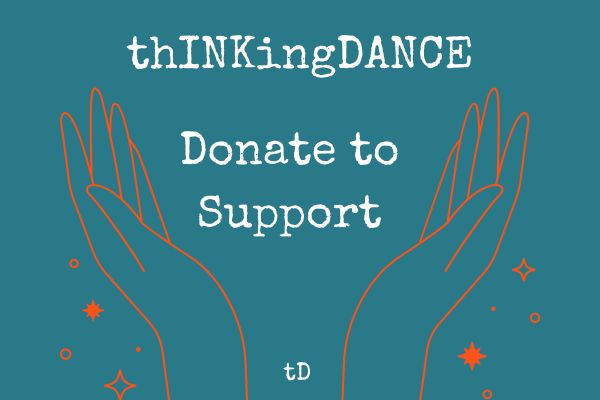In her collection of essays, Hiking the Horizontal, Liz Lerman asks us, “Who Gets to Dance?” She tells stories of dancing port workers, writes manifestos in the form of Village Voice help wanted ads, and talks of technique. But one of the more critical answers to her question is a short essay on her work with dancers over the age of 65 and how movement in any form should not be held to the standard of the virtuosic 20 year old body, the neoliberal body that is ready for anything at all times. Movement should be a message, a way of making meaning through embodied knowledge. And who better to share stories like that than those who have experienced more? Temple University’s commission from Terry Beck investigates what lies beyond age through three interwoven pieces: Improvisation, DIG, and the premiere of Harbour.
In Improvisation Beck dances to a live soundscore being played and mixed onstage by longtime composer and collaborator David Rudge. A white cloth cuts the stage in half, leaving only the downstage area as the playing space. Five lonely lamps suspended from the rigging hang down, their warm light casting shadows on the floor (Liam Henry Boyd Shaffer’s lighting dazzles and breathes life into the space throughout the three pieces). As a projection of a man with liver spots and bags under his eyes appears, so does Beck on the stage. He navigates swiftly through gestures: a hand on the back into a deep plié, a hand on the chin, then collarbones into a stomp of the toes firmly on the ground. He brushes against the lights above, eventually taking hold and swinging them like pendulums, the lights flickering against the audience and Beck. He continues his line, back and forth, back and forth, parallel to the white cloth. “I still see him in my dreams,” says the soundscore. “He was like a little angel.”
DIG comes next, a powerful duet restaged with Tim Early and Haotan Liu. The stage crew meticulously fills five squares of reddish dirt before the piece starts. The Squares are scattered around the stage, and they tamp it down with the cup used to pour from bucket to floor. A center spotlight comes up, illuminating a bowl of water resting on a green patch of grass. Liu’s hand reaches up towards the light, then turns to move toward the water, flicking it. Early enters, hands are filled with what appear to be white petals; he scatters and throws them up into the air, not quite joyously but something else. His empty hands reach towards his mouth – pulling out what? He looks, then dances away. His lines are clean and long, efficient as he turns and leaps, scattering dirt everywhere with both feet and hands, flinging it into the air as he did the petals. Liu and Early repeat a canon phrase over and over, speeding it up. As Liu – young and confident, the only dancer under middle age – continues to the point of frenzy, Early approaches him, holding him from behind as Liu gently struggles, then relents. What does it mean to give in? To give in to the earth, to age?
After a brief intermission, Harbour – divided into three distinct parts – begins. Several set pieces, designed by Beck and Mitch Fitzgibbon, adorn the stage: a cluster of wood window frames with a shining beacon inside, a small vintage pianoforte-looking instrument, and a beautiful driftwood throne with a long, black fishnet emerging from it. In the back, Terry Beck rows in a small boat covered in clocks, all ticking at different times. While he continues his metered journey, the rest of the company enters for Siren. Their white robes are torn and tattered, reminiscent of sails long abandoned. Brenda Dixon Gottschild leads the crowd, seated on the throne, as she keens and caws, rubbing her knees. The dancers talk to themselves, muttering, turning into shouting, the only discernible word being “anyways,” thrown to the audience by each dancer as they change their subject or continue on with their story. They pluck at the air, their skin, grabbing at nothing, unsatisfied.
The company steps in time with each other as Gottschild continues her wailing, grasping at her head in staccato poses. As Gottschild rises from her throne, they drag it and the net away, revealing two dancers. Lighthouse begins an exploration of intimacy. Tim Early and Janet Pilla Marini delve into space and each other, dropping in and out of the floor, arms raised. They continue the plucking motions from earlier, with a little more weightedness. They sink in and out of each other’s gaze. As they back into the light of the window lamp, Early bows and kneels towards Marini, who has eyes only for the lamp’s light. He exits remorsefully, and she backs out, still focusing on the light. Beck finally rises out of the boat. The Bardo flicks and floats across the stage in a diagonal line, gazing at the boat now and then. “My story begins very simply,” says the score. “I could speak, and I was happy.” Indeed, Beck speaks to us through his kinetic storytelling, allowing us to witness his many shifts and turns in gesture along the way. “When one begins, there are only endings,” says a voice.
Beck’s works share gestures and spatial discoveries across each other, lending to the concert feeling suggestive of itself, holding hands with the audience members as if to say remember me? In an afterword with the panel of dancers, he proclaims that he doesn’t write program notes because he wants the audience to do its own thinking and exploration of affective responses. The audience popcorns around with what they saw, and no two answers are the same; Beck seems to glow and lean into the discrepancies. How delightful to explore each and every one of his ‘endings.’
What a wonderful way to view a career’s worth of dancing.
Reflection: Response Commission 2024: Terry Beck BYR ‘79, Tomlinson Theater, September 6-7.
Homepage Image Description: In a blank expanse, a boat, a small wooden toy piano, and several clocks of various sizes pointing to different times are illuminated. In the boat sits Terry Beck, an older white man in a velvet jacket with coiffed hair. His eyes are closed as he raises one hand to his cheek and the other to the sky.
Article Image Description: Lit by a speckled gobo pattern, several dancers are turned at a 3/4 angle in a clump surrounding a throne of driftwood, where Brenda Dixon Gottschild, an older Black woman, sits. Their faces are all contorted into screams, or songs.






